SpringBoot+Dubbo+Nacos development practical tutorial
dubbo nacos Spring Boot. This article will not cover too much theoretical knowledge, but will write the simplest example to illustrate how dubbo can be integrated with nacos to quickly build a development environment.Article Directory
- ##Environment preparation
- dubbo introduction
- Nacos environment preparation
- Integration of Nacos and dubbo
- Project management specifications
- dubbo integration nacos case
- Create public interface module
- Create service provider module
- Create service consumer module
- Service call test
- Summary of this article
Environment preparation
Calling relationship between dubbo core nodes
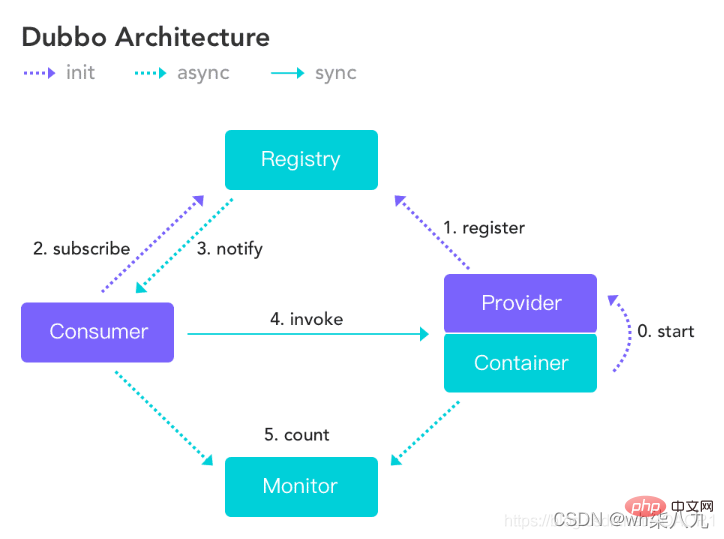 Node description
Node description
Calling relationship description
The service container is responsible for starting, loading, and running the service provider. When the service provider starts, it registers the services it provides with the registration center. When the service consumer starts, he subscribes to the registration center for the services he needs. The registration center returns the service provider address list to the consumer. If there is a change, the registration center will push the change data to the consumer based on the long connection. The service consumer selects a provider to call from the provider address list based on the soft load balancing algorithm. If the call fails, it selects another provider to call. Service consumers and providers accumulate the number of calls and call times in memory, and regularly send statistical data to the monitoring center every minute.
Nacos environment preparation
Start nacos, this article uses nacos1 .4.3 version
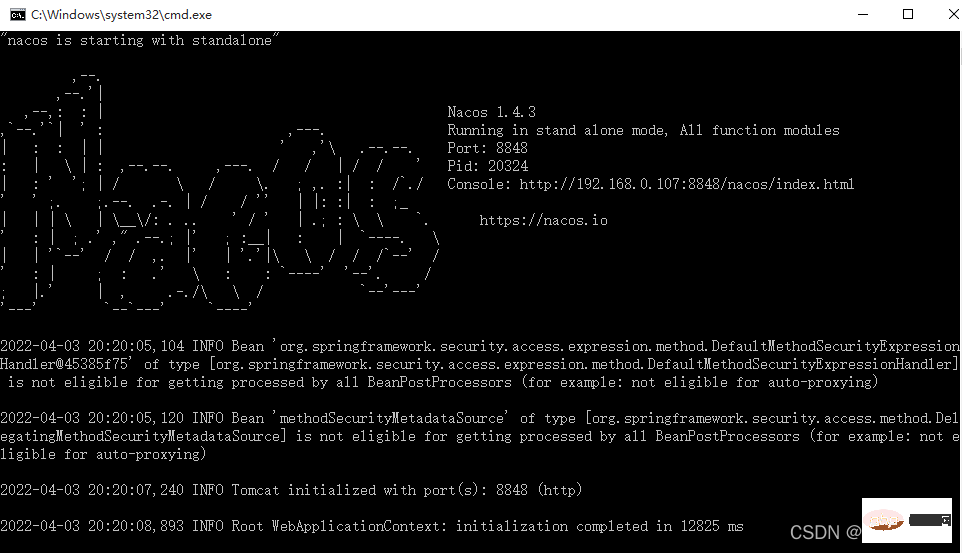
Open nacos control panel
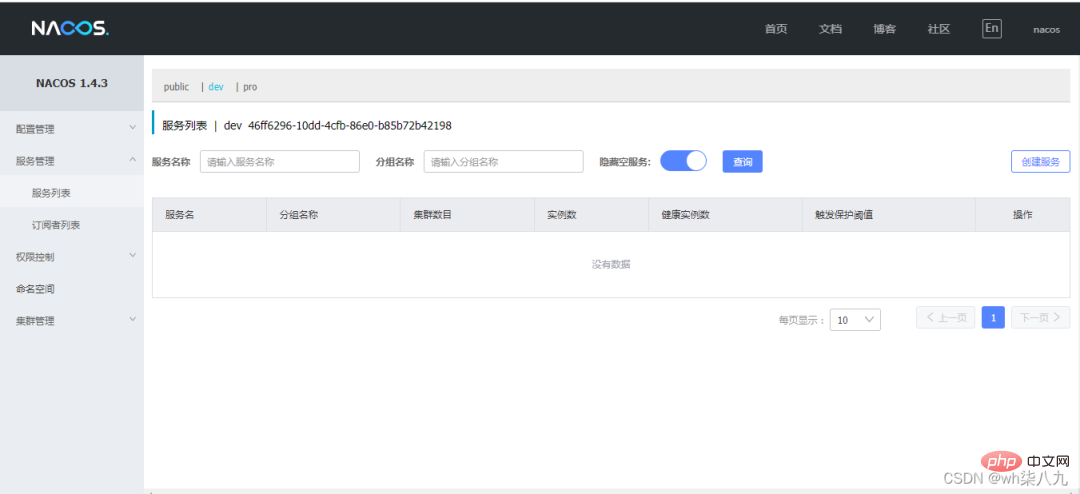
Integration of Nacos and dubbo
For the convenience of everyone’s understanding, here it is written Output the corresponding producer and consumer Demo codes, as well as the registration center used.
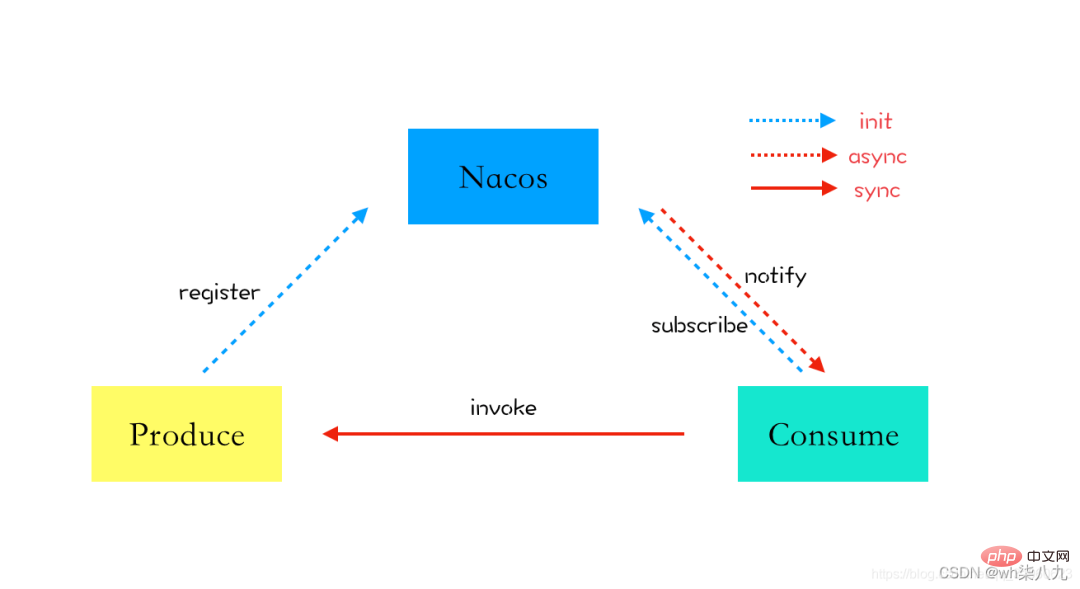
Project management specifications
Between springboot, netflix and cloud alibaba There is a corresponding relationship between versions. The version selected for this article is as follows
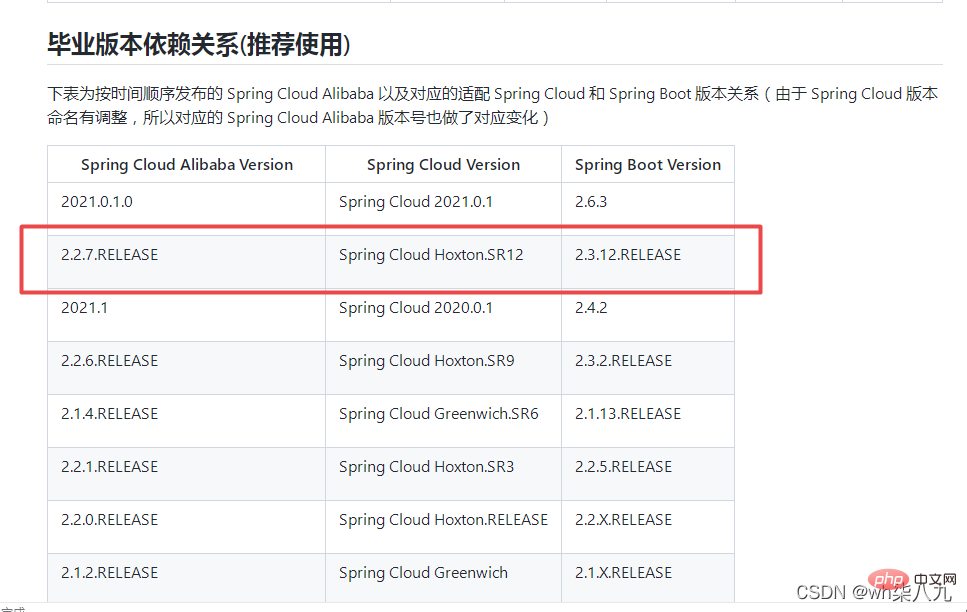
There is a corresponding relationship between dubbo and cloud alibaba. The version selected for this article is as follows
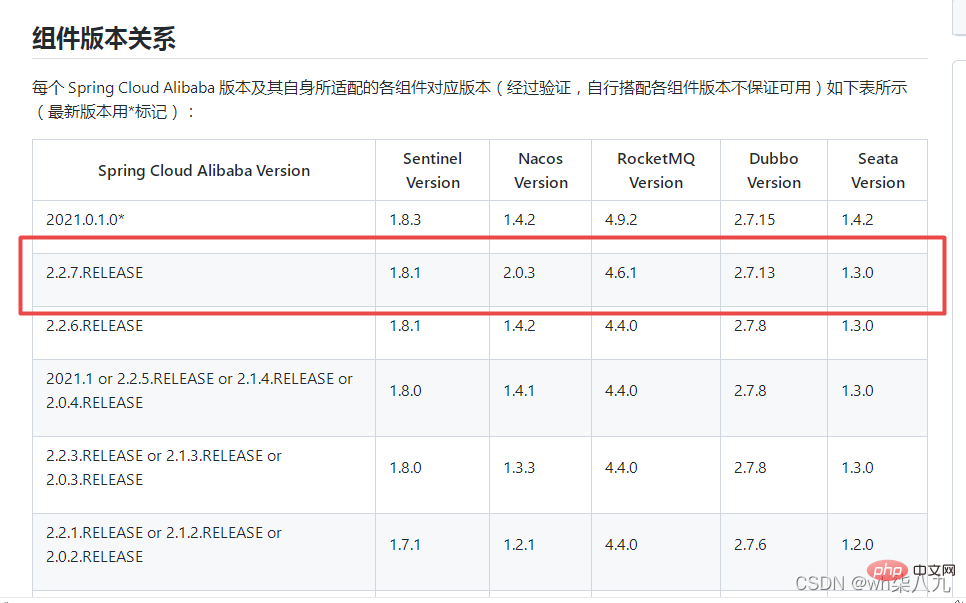
In order to facilitate subsequent development using SpringCloud Alibaba, first create a parent project of pom type, which is mainly used for project technology stack version management, and create a maven project. The name is spring-cloud-alibaba-example, remove the src file and modify the pom file
<?xml version="1.0" encoding="UTF-8"?>
<project xmlns="http://maven.apache.org/POM/4.0.0"
xmlns:xsi="http://www.w3.org/2001/XMLSchema-instance"
xsi:schemaLocation="http://maven.apache.org/POM/4.0.0 http://maven.apache.org/xsd/maven-4.0.0.xsd">
<modelVersion>4.0.0</modelVersion>
<groupId>ah.wideth</groupId>
<artifactId>spring-cloud-alibaba-example</artifactId>
<version>1.0-SNAPSHOT</version>
<parent>
<groupId>org.springframework.boot</groupId>
<artifactId>spring-boot-starter-parent</artifactId>
<version>2.3.12.RELEASE</version>
<relativePath/> <!-- lookup parent from repository -->
</parent>
<packaging>pom</packaging>
<properties>
<project.build.sourceEncoding>UTF-8</project.build.sourceEncoding>
<java.version>1.8</java.version>
<spring-cloud.version>Hoxton.SR12</spring-cloud.version>
<com-alibaba-cloud.version>2.2.7.RELEASE</com-alibaba-cloud.version>
</properties>
<!--对项目版本进行管理-->
<dependencyManagement>
<dependencies>
<dependency>
<groupId>org.springframework.cloud</groupId>
<artifactId>spring-cloud-dependencies</artifactId>
<version>${spring-cloud.version}</version>
<type>pom</type>
<scope>import</scope>
</dependency>
<dependency>
<groupId>com.alibaba.cloud</groupId>
<artifactId>spring-cloud-alibaba-dependencies</artifactId>
<version>${com-alibaba-cloud.version}</version>
<type>pom</type>
<scope>import</scope>
</dependency>
</dependencies>
</dependencyManagement>
</project> All subsequent projects created will be placed in this directory. You only need to declare the groupId and artifactId, and it will automatically Reference the version of the parent project spring-cloud-alibaba-example. Rather than saying it is a parent project, it is better to say it is a root project: because every time you learn a new technology, a real parent project will be created, and many sub-projects will be created under the corresponding parent project
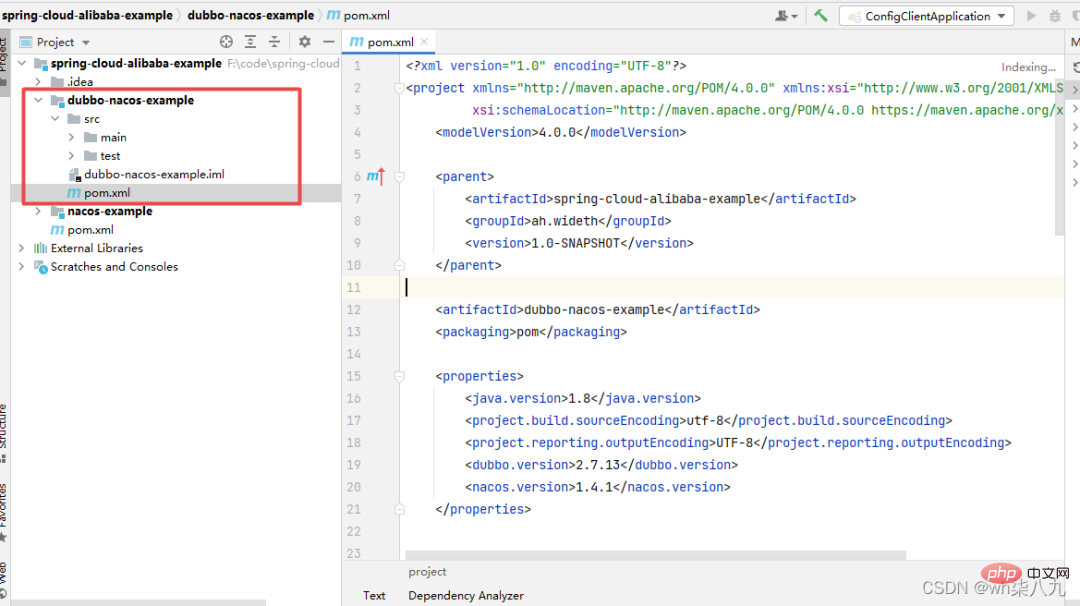
dubbo integration nacos case
The case in this article is the above nacos development example Continuing to write on the basis of. Let's start creating our project and paste my directory structure.
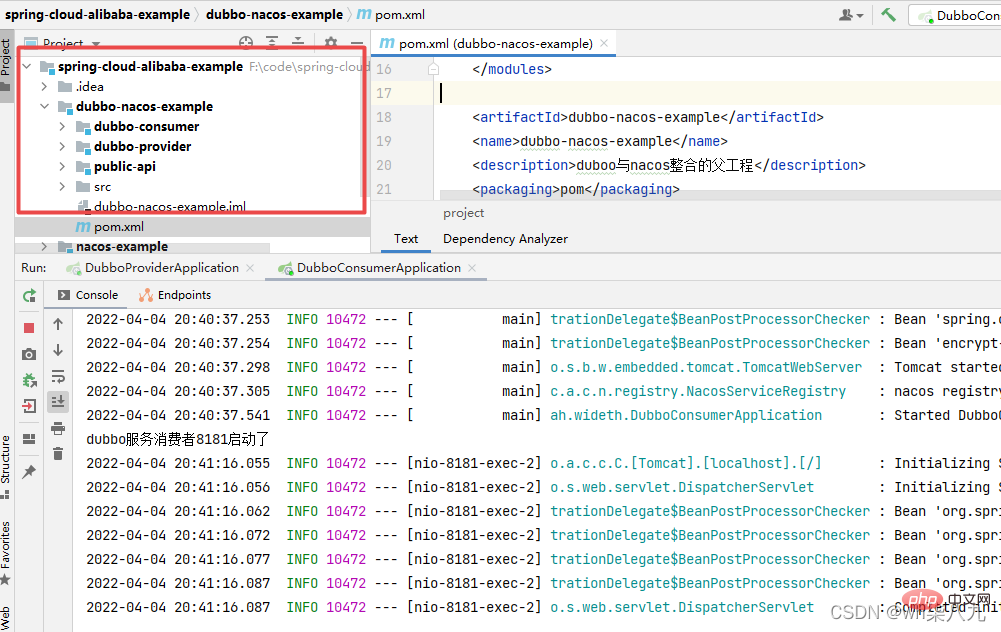
Module Description
public-api公共接口模块(接口),供服务消费者和服务提供者调用。dubbo-provider服务提供者模块(接口实现类),引入了public-api模块dubbo-consumer服务消费者模块(controller),引入了public-api模块消费者和提供者通过公共接口模块进行rpc远程调用
父工程pom文件
<?xml version="1.0" encoding="UTF-8"?>
<project xmlns="http://maven.apache.org/POM/4.0.0" xmlns:xsi="http://www.w3.org/2001/XMLSchema-instance"
xsi:schemaLocation="http://maven.apache.org/POM/4.0.0 https://maven.apache.org/xsd/maven-4.0.0.xsd">
<modelVersion>4.0.0</modelVersion>
<parent>
<artifactId>spring-cloud-alibaba-example</artifactId>
<groupId>ah.wideth</groupId>
<version>1.0-SNAPSHOT</version>
</parent>
<modules>
<module>public-api</module>
<module>dubbo-provider</module>
<module>dubbo-consumer</module>
</modules>
<artifactId>dubbo-nacos-example</artifactId>
<name>dubbo-nacos-example</name>
<description>duboo与nacos整合的父工程</description>
<packaging>pom</packaging>
<properties>
<java.version>1.8</java.version>
<project.build.sourceEncoding>utf-8</project.build.sourceEncoding>
<project.reporting.outputEncoding>UTF-8</project.reporting.outputEncoding>
<dubbo.version>2.7.13</dubbo.version>
<nacos.version>1.4.1</nacos.version>
</properties>
<dependencies>
<dependency>
<groupId>com.alibaba.cloud</groupId>
<artifactId>spring-cloud-starter-alibaba-nacos-discovery</artifactId>
<!--解决nacos-client2.0报错的问题-->
<exclusions>
<exclusion>
<artifactId>nacos-client</artifactId>
<groupId>com.alibaba.nacos</groupId>
</exclusion>
</exclusions>
</dependency>
<!--dubbo相关-->
<dependency>
<groupId>org.apache.dubbo</groupId>
<artifactId>dubbo-spring-boot-starter</artifactId>
<version>${dubbo.version}</version>
</dependency>
<dependency>
<groupId>org.apache.dubbo</groupId>
<artifactId>dubbo-registry-nacos</artifactId>
<version>${dubbo.version}</version>
</dependency>
<dependency>
<groupId>com.alibaba.nacos</groupId>
<artifactId>nacos-client</artifactId>
<version>${nacos.version}</version>
</dependency>
<!-- 解决dubbo2.7.13jar包冲突问题-->
<dependency>
<groupId>com.alibaba.spring</groupId>
<artifactId>spring-context-support</artifactId>
<version>1.0.11</version>
</dependency>
<dependency>
<groupId>org.apache.dubbo</groupId>
<artifactId>dubbo</artifactId>
<version>${dubbo.version}</version>
<exclusions>
<exclusion>
<groupId>org.springframework</groupId>
<artifactId>spring</artifactId>
</exclusion>
<exclusion>
<groupId>javax.servlet</groupId>
<artifactId>servlet-api</artifactId>
</exclusion>
<exclusion>
<groupId>log4j</groupId>
<artifactId>log4j</artifactId>
</exclusion>
</exclusions>
</dependency>
</dependencies>
</project>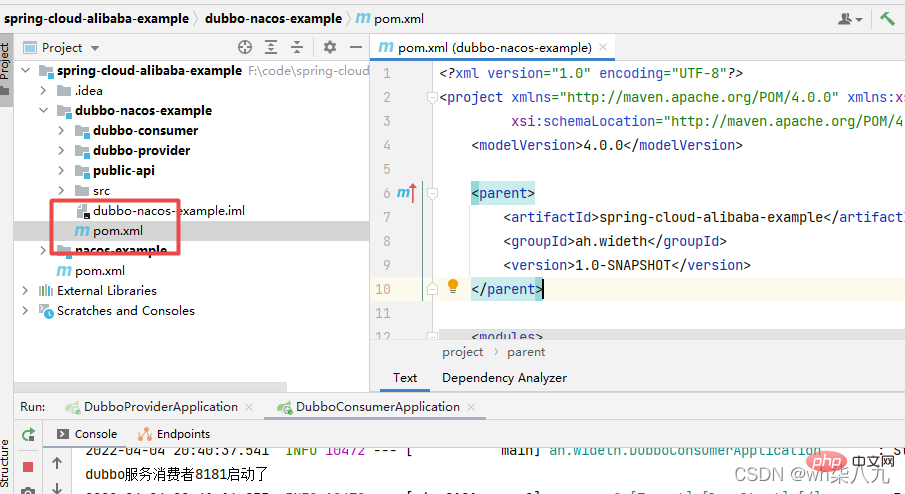
创建公共接口模块
pom文件
<?xml version="1.0" encoding="UTF-8"?>
<project xmlns="http://maven.apache.org/POM/4.0.0" xmlns:xsi="http://www.w3.org/2001/XMLSchema-instance"
xsi:schemaLocation="http://maven.apache.org/POM/4.0.0 https://maven.apache.org/xsd/maven-4.0.0.xsd">
<modelVersion>4.0.0</modelVersion>
<parent>
<artifactId>dubbo-nacos-example</artifactId>
<groupId>ah.wideth</groupId>
<version>1.0-SNAPSHOT</version>
</parent>
<artifactId>public-api</artifactId>
<name>public-api</name>
<description>api公用接口</description>
<packaging>jar</packaging>
<properties>
<java.version>1.8</java.version>
<project.build.sourceEncoding>utf-8</project.build.sourceEncoding>
<project.reporting.outputEncoding>UTF-8</project.reporting.outputEncoding>
</properties>
<dependencies>
<dependency>
<groupId>org.springframework.boot</groupId>
<artifactId>spring-boot-starter-web</artifactId>
</dependency>
</dependencies>
<build>
<plugins>
<plugin>
<groupId>org.springframework.boot</groupId>
<artifactId>spring-boot-maven-plugin</artifactId>
</plugin>
</plugins>
</build>
</project>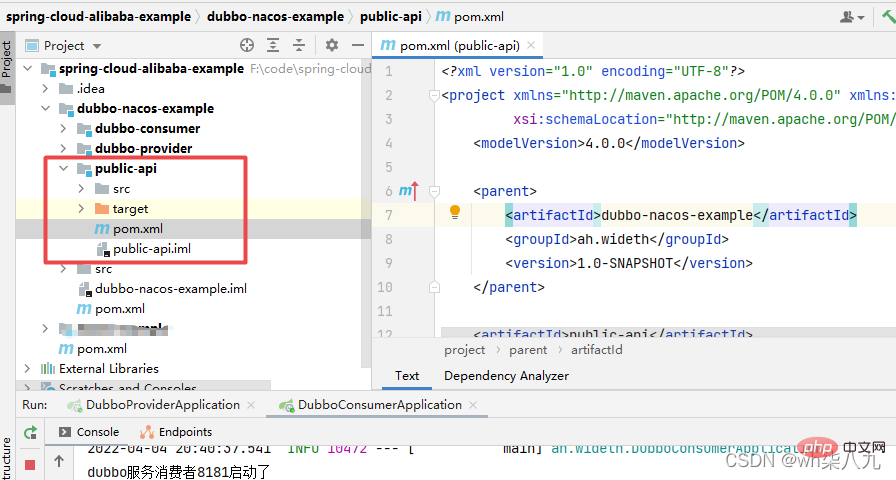
公共接口模块里面只有一个接口,没有配置文件,打jar包
package ah.wideth.api;
/**
* 让生产者和服务消
* 费者来使用这个接口
*/
public interface InfoService {
String getInfo();
}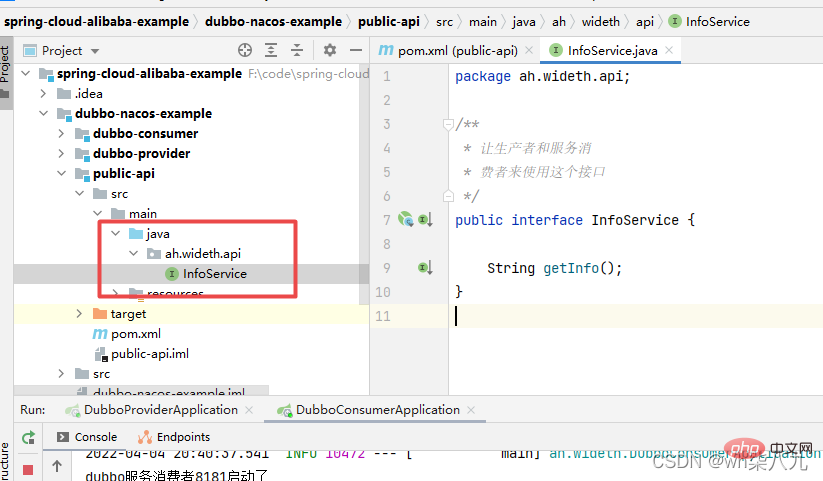
创建服务提供者模块
pom文件
<?xml version="1.0" encoding="UTF-8"?>
<project xmlns="http://maven.apache.org/POM/4.0.0" xmlns:xsi="http://www.w3.org/2001/XMLSchema-instance"
xsi:schemaLocation="http://maven.apache.org/POM/4.0.0 https://maven.apache.org/xsd/maven-4.0.0.xsd">
<modelVersion>4.0.0</modelVersion>
<parent>
<artifactId>dubbo-nacos-example</artifactId>
<groupId>ah.wideth</groupId>
<version>1.0-SNAPSHOT</version>
</parent>
<artifactId>dubbo-provider</artifactId>
<name>dubbo-provider</name>
<description>dubbo的服务提供者模块</description>
<properties>
<java.version>1.8</java.version>
<project.build.sourceEncoding>utf-8</project.build.sourceEncoding>
<project.reporting.outputEncoding>UTF-8</project.reporting.outputEncoding>
</properties>
<dependencies>
<dependency>
<groupId>org.springframework.boot</groupId>
<artifactId>spring-boot-starter-web</artifactId>
</dependency>
<!--引入公共接口模块-->
<dependency>
<groupId>${project.groupId}</groupId>
<artifactId>public-api</artifactId>
<version>${project.version}</version>
</dependency>
</dependencies>
<build>
<plugins>
<plugin>
<groupId>org.springframework.boot</groupId>
<artifactId>spring-boot-maven-plugin</artifactId>
</plugin>
</plugins>
</build>
</project>application.yml配置文件
server:
port: 8180
spring:
application:
name: dubbo-provider
dubbo:
registry:
address: nacos://127.0.0.1:8848 #注册地址
application:
name: dubbo-provider #应用名
protocol:
name: dubbo #dubbo协议
port: 20880 #协议端口
scan:
base-packages: ah.wideth.impl #扫包范围
provider:
timeout: 30000 #超时时间接口实现类,该类实现了上面我们在公共接口模块创建的接口
package ah.wideth.impl;
import ah.wideth.api.InfoService;
import org.apache.dubbo.config.annotation.DubboService;
import org.springframework.stereotype.Component;
// dubbo提供的Service注解,用于声明对外暴露服务
// Service引入的是org.apache.dubbo.config.annotation.Service包
@Component
@DubboService
public class InfoServiceImpl implements InfoService {
@Override
public String getInfo() {
return "hello,这里是dubbo-provider模块!";
}
}服务提供者启动类
package ah.wideth;
import org.apache.dubbo.config.spring.context.annotation.EnableDubbo;
import org.springframework.boot.SpringApplication;
import org.springframework.boot.autoconfigure.SpringBootApplication;
import org.springframework.cloud.client.discovery.EnableDiscoveryClient;
@EnableDubbo
@EnableDiscoveryClient
@SpringBootApplication
public class DubboProviderApplication {
public static void main(String[] args) {
SpringApplication.run(DubboProviderApplication.class, args);
System.out.println("dubbo服务提供者8180启动了");
}
}创建服务消费者模块
pom文件
<?xml version="1.0" encoding="UTF-8"?>
<project xmlns="http://maven.apache.org/POM/4.0.0" xmlns:xsi="http://www.w3.org/2001/XMLSchema-instance"
xsi:schemaLocation="http://maven.apache.org/POM/4.0.0 https://maven.apache.org/xsd/maven-4.0.0.xsd">
<modelVersion>4.0.0</modelVersion>
<parent>
<artifactId>dubbo-nacos-example</artifactId>
<groupId>ah.wideth</groupId>
<version>1.0-SNAPSHOT</version>
</parent>
<artifactId>dubbo-consumer</artifactId>
<name>dubbo-consumer</name>
<description>dubbo的服务消费者模块</description>
<properties>
<java.version>1.8</java.version>
<project.build.sourceEncoding>utf-8</project.build.sourceEncoding>
<project.reporting.outputEncoding>UTF-8</project.reporting.outputEncoding>
</properties>
<dependencies>
<dependency>
<groupId>org.springframework.boot</groupId>
<artifactId>spring-boot-starter-web</artifactId>
</dependency>
<!--引入公共接口模块-->
<dependency>
<groupId>${project.groupId}</groupId>
<artifactId>public-api</artifactId>
<version>${project.version}</version>
</dependency>
</dependencies>
<build>
<plugins>
<plugin>
<groupId>org.springframework.boot</groupId>
<artifactId>spring-boot-maven-plugin</artifactId>
</plugin>
</plugins>
</build>
</project>application.yml配置文件
server:
port: 8181
spring:
application:
name: dubbo-consumer
dubbo:
registry:
address: nacos://127.0.0.1:8848 #注册地址
application:
name: dubbo-consumer #应用名
consumer:
timeout: 30000 #超时时间controller,调用公共接口模块创建的接口
package ah.wideth.controller;
import ah.wideth.api.InfoService;
import org.apache.dubbo.config.annotation.DubboReference;
import org.springframework.web.bind.annotation.GetMapping;
import org.springframework.web.bind.annotation.RestController;
@RestController
public class InfoController {
//dumbo提供的Reference注解,用于调用远程服务
@DubboReference(check = false)
private InfoService infoService;
@GetMapping("/getInfo")
public String getInfo(){
return infoService.getInfo();
}
}服务消费者启动类
package ah.wideth;
import org.apache.dubbo.config.spring.context.annotation.EnableDubbo;
import org.springframework.boot.SpringApplication;
import org.springframework.boot.autoconfigure.SpringBootApplication;
import org.springframework.cloud.client.discovery.EnableDiscoveryClient;
@EnableDubbo
@EnableDiscoveryClient
@SpringBootApplication
public class DubboConsumerApplication {
public static void main(String[] args) {
SpringApplication.run(DubboConsumerApplication.class, args);
System.out.println("dubbo服务消费者8181启动了");
}
}服务调用测试
打开Nacos控制面板查看注册中心中的服务
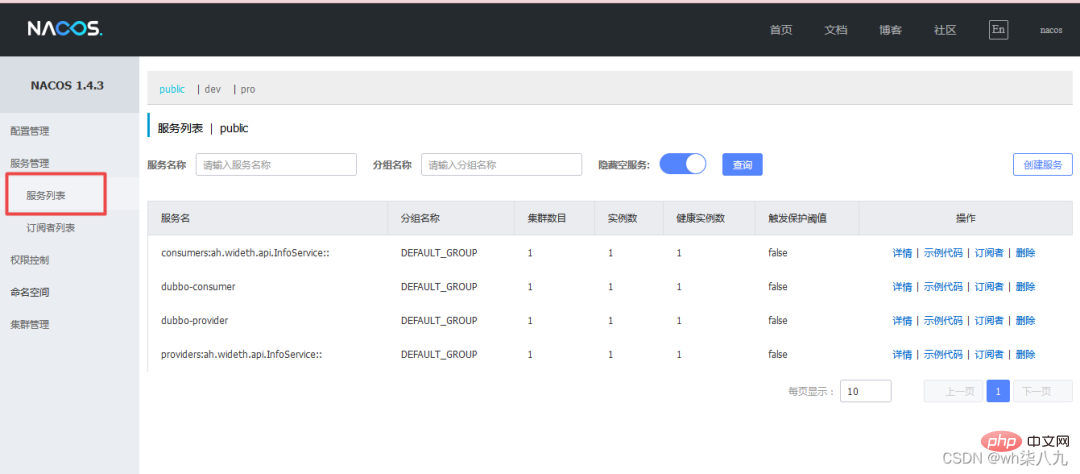
启动nacos,启动服务提供者和服务消费者,调用服务消费者的getInfo方法,服务提供者会返回结果

本文小结
本文编写了一个例子来对dubbo整合nacos进行服务调用的例子,不过要注意jar包的冲突问题。
The above is the detailed content of SpringBoot+Dubbo+Nacos development practical tutorial. For more information, please follow other related articles on the PHP Chinese website!

Hot AI Tools

Undresser.AI Undress
AI-powered app for creating realistic nude photos

AI Clothes Remover
Online AI tool for removing clothes from photos.

Undress AI Tool
Undress images for free

Clothoff.io
AI clothes remover

AI Hentai Generator
Generate AI Hentai for free.

Hot Article

Hot Tools

Notepad++7.3.1
Easy-to-use and free code editor

SublimeText3 Chinese version
Chinese version, very easy to use

Zend Studio 13.0.1
Powerful PHP integrated development environment

Dreamweaver CS6
Visual web development tools

SublimeText3 Mac version
God-level code editing software (SublimeText3)

Hot Topics
 1377
1377
 52
52
 How Springboot integrates Jasypt to implement configuration file encryption
Jun 01, 2023 am 08:55 AM
How Springboot integrates Jasypt to implement configuration file encryption
Jun 01, 2023 am 08:55 AM
Introduction to Jasypt Jasypt is a java library that allows a developer to add basic encryption functionality to his/her project with minimal effort and does not require a deep understanding of how encryption works. High security for one-way and two-way encryption. , standards-based encryption technology. Encrypt passwords, text, numbers, binaries... Suitable for integration into Spring-based applications, open API, for use with any JCE provider... Add the following dependency: com.github.ulisesbocchiojasypt-spring-boot-starter2. 1.1Jasypt benefits protect our system security. Even if the code is leaked, the data source can be guaranteed.
 How to use Redis to implement distributed locks in SpringBoot
Jun 03, 2023 am 08:16 AM
How to use Redis to implement distributed locks in SpringBoot
Jun 03, 2023 am 08:16 AM
1. Redis implements distributed lock principle and why distributed locks are needed. Before talking about distributed locks, it is necessary to explain why distributed locks are needed. The opposite of distributed locks is stand-alone locks. When we write multi-threaded programs, we avoid data problems caused by operating a shared variable at the same time. We usually use a lock to mutually exclude the shared variables to ensure the correctness of the shared variables. Its scope of use is in the same process. If there are multiple processes that need to operate a shared resource at the same time, how can they be mutually exclusive? Today's business applications are usually microservice architecture, which also means that one application will deploy multiple processes. If multiple processes need to modify the same row of records in MySQL, in order to avoid dirty data caused by out-of-order operations, distribution needs to be introduced at this time. The style is locked. Want to achieve points
 How to solve the problem that springboot cannot access the file after reading it into a jar package
Jun 03, 2023 pm 04:38 PM
How to solve the problem that springboot cannot access the file after reading it into a jar package
Jun 03, 2023 pm 04:38 PM
Springboot reads the file, but cannot access the latest development after packaging it into a jar package. There is a situation where springboot cannot read the file after packaging it into a jar package. The reason is that after packaging, the virtual path of the file is invalid and can only be accessed through the stream. Read. The file is under resources publicvoidtest(){Listnames=newArrayList();InputStreamReaderread=null;try{ClassPathResourceresource=newClassPathResource("name.txt");Input
 Comparison and difference analysis between SpringBoot and SpringMVC
Dec 29, 2023 am 11:02 AM
Comparison and difference analysis between SpringBoot and SpringMVC
Dec 29, 2023 am 11:02 AM
SpringBoot and SpringMVC are both commonly used frameworks in Java development, but there are some obvious differences between them. This article will explore the features and uses of these two frameworks and compare their differences. First, let's learn about SpringBoot. SpringBoot was developed by the Pivotal team to simplify the creation and deployment of applications based on the Spring framework. It provides a fast, lightweight way to build stand-alone, executable
 How to implement Springboot+Mybatis-plus without using SQL statements to add multiple tables
Jun 02, 2023 am 11:07 AM
How to implement Springboot+Mybatis-plus without using SQL statements to add multiple tables
Jun 02, 2023 am 11:07 AM
When Springboot+Mybatis-plus does not use SQL statements to perform multi-table adding operations, the problems I encountered are decomposed by simulating thinking in the test environment: Create a BrandDTO object with parameters to simulate passing parameters to the background. We all know that it is extremely difficult to perform multi-table operations in Mybatis-plus. If you do not use tools such as Mybatis-plus-join, you can only configure the corresponding Mapper.xml file and configure The smelly and long ResultMap, and then write the corresponding sql statement. Although this method seems cumbersome, it is highly flexible and allows us to
 How SpringBoot customizes Redis to implement cache serialization
Jun 03, 2023 am 11:32 AM
How SpringBoot customizes Redis to implement cache serialization
Jun 03, 2023 am 11:32 AM
1. Customize RedisTemplate1.1, RedisAPI default serialization mechanism. The API-based Redis cache implementation uses the RedisTemplate template for data caching operations. Here, open the RedisTemplate class and view the source code information of the class. publicclassRedisTemplateextendsRedisAccessorimplementsRedisOperations, BeanClassLoaderAware{//Declare key, Various serialization methods of value, the initial value is empty @NullableprivateRedisSe
 How to get the value in application.yml in springboot
Jun 03, 2023 pm 06:43 PM
How to get the value in application.yml in springboot
Jun 03, 2023 pm 06:43 PM
In projects, some configuration information is often needed. This information may have different configurations in the test environment and the production environment, and may need to be modified later based on actual business conditions. We cannot hard-code these configurations in the code. It is best to write them in the configuration file. For example, you can write this information in the application.yml file. So, how to get or use this address in the code? There are 2 methods. Method 1: We can get the value corresponding to the key in the configuration file (application.yml) through the ${key} annotated with @Value. This method is suitable for situations where there are relatively few microservices. Method 2: In actual projects, When business is complicated, logic
 SpringBoot+Dubbo+Nacos development practical tutorial
Aug 15, 2023 pm 04:49 PM
SpringBoot+Dubbo+Nacos development practical tutorial
Aug 15, 2023 pm 04:49 PM
This article will write a detailed example to talk about the actual development of dubbo+nacos+Spring Boot. This article will not cover too much theoretical knowledge, but will write the simplest example to illustrate how dubbo can be integrated with nacos to quickly build a development environment.




